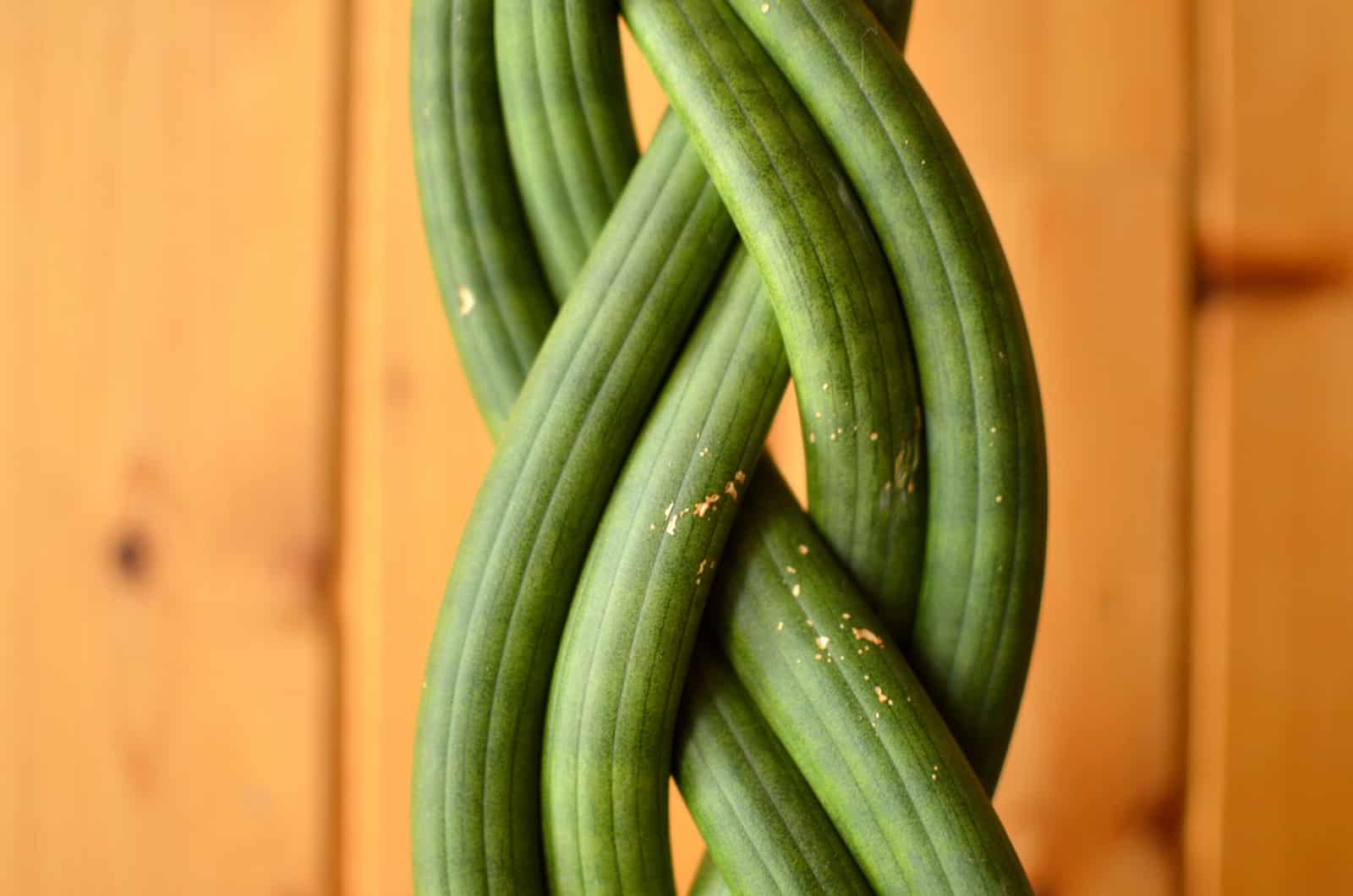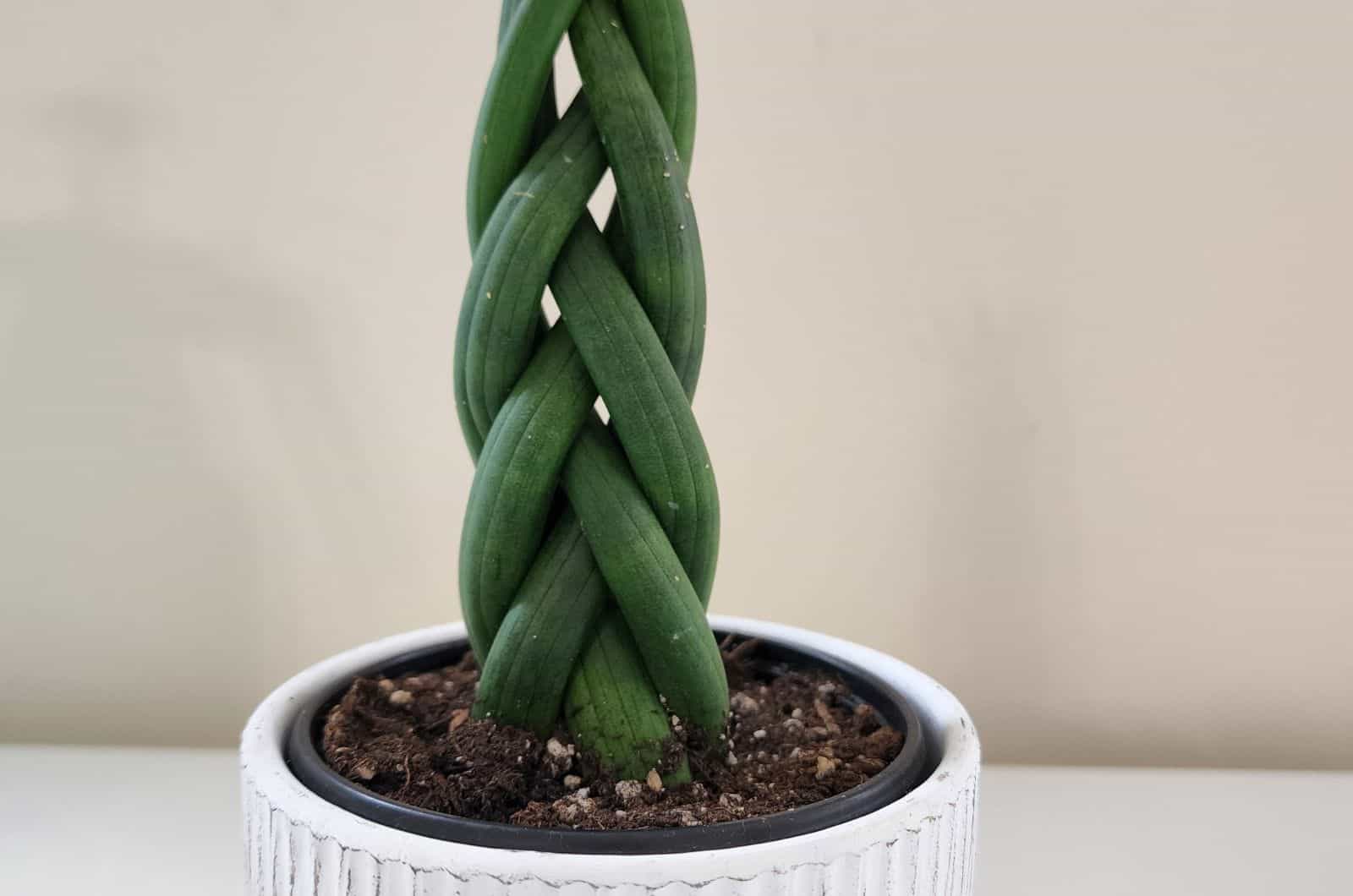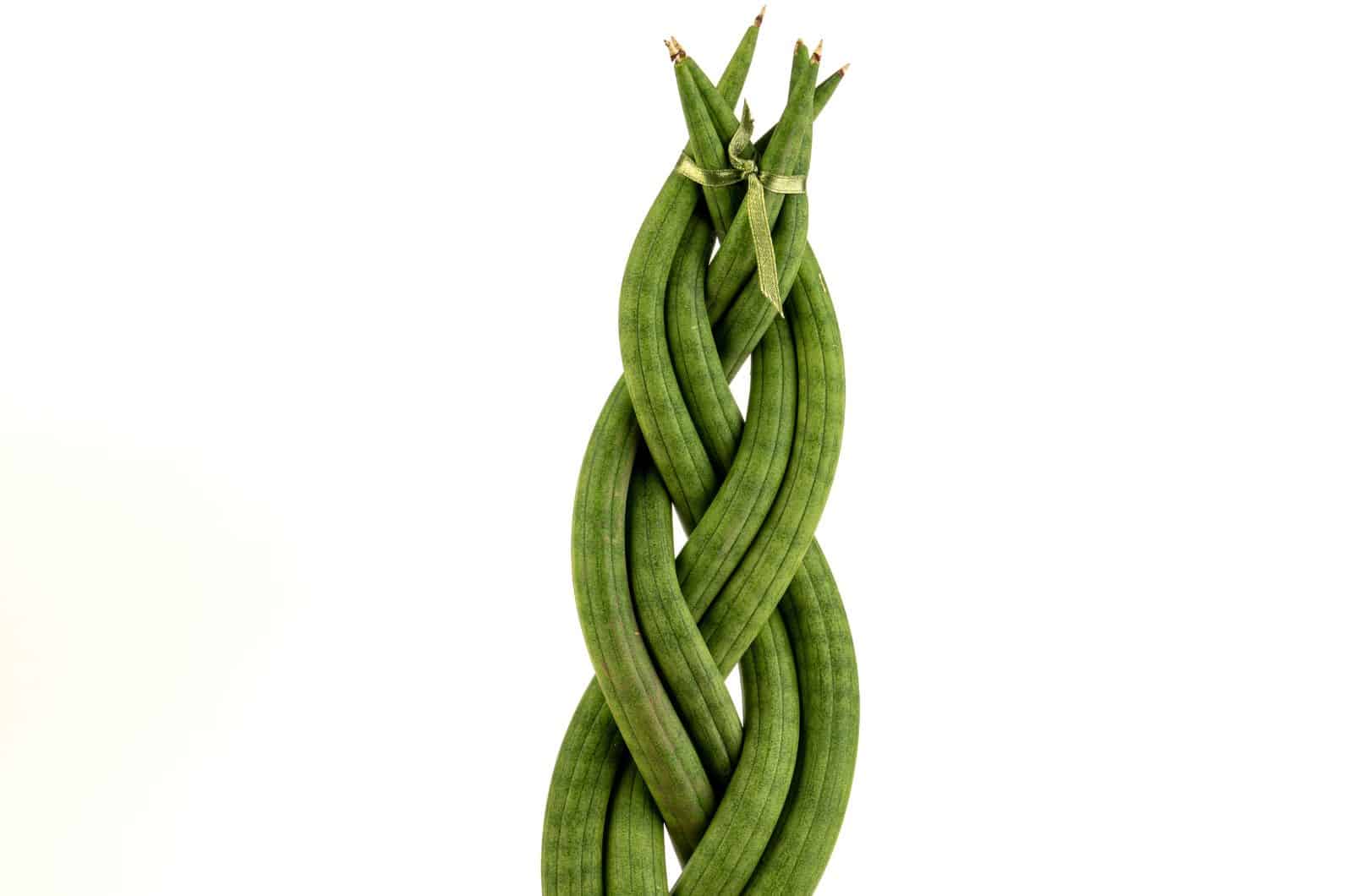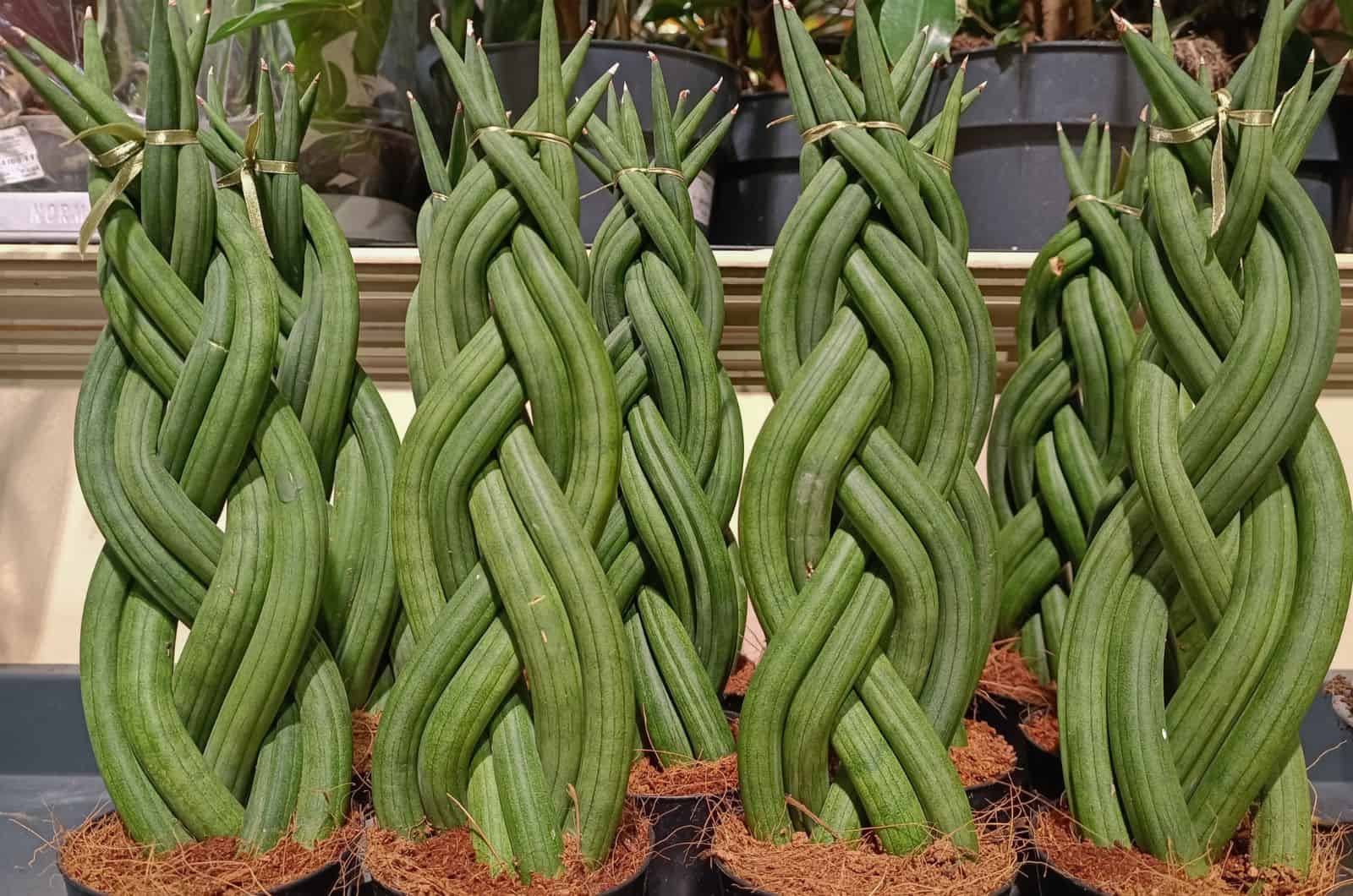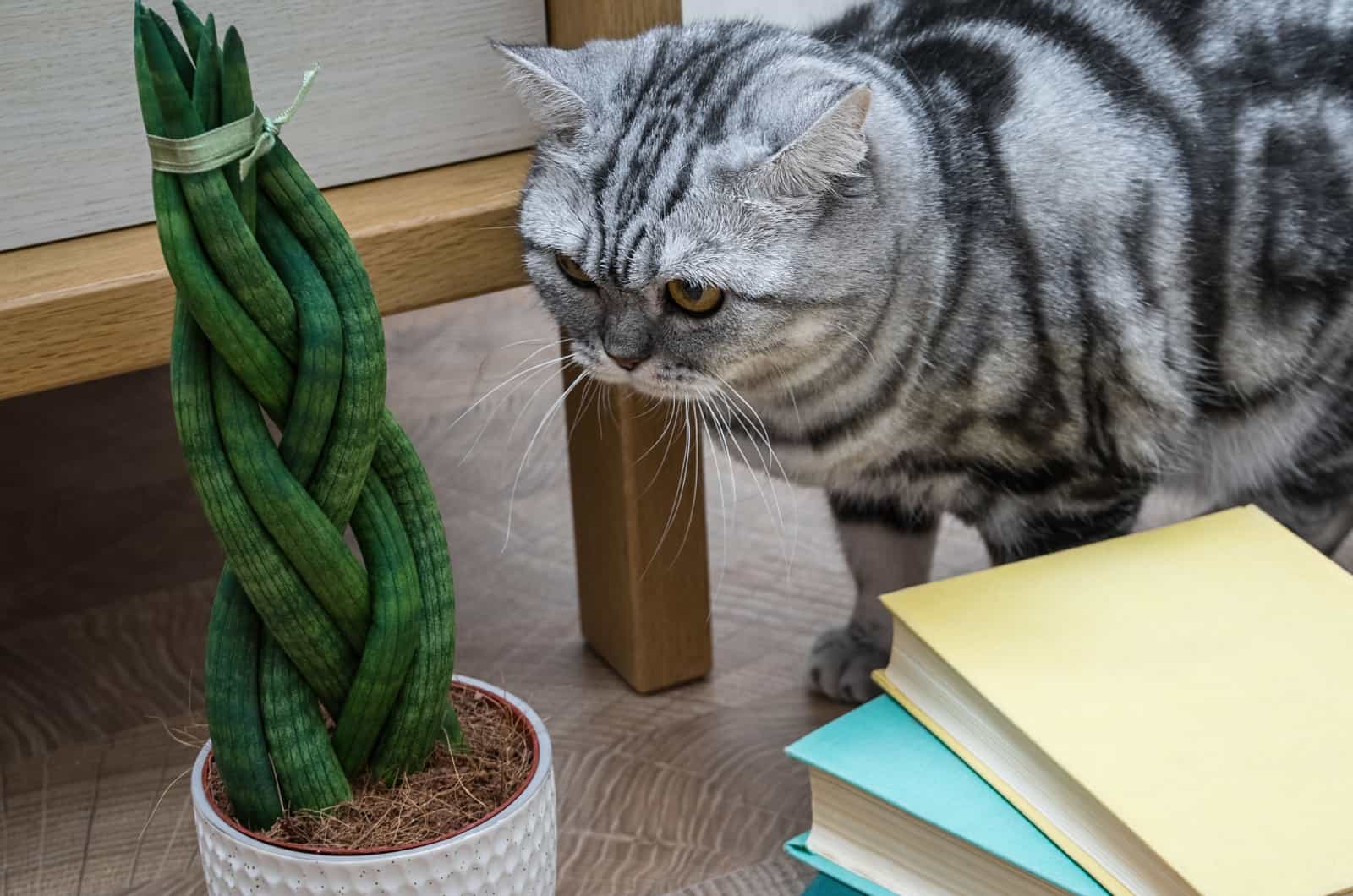I’m sure that you have already heard about the famous and low-maintenance houseplants called Snake plants (also known as Mother-in-law’s tongue).
While most Snake plants have firm, sword-like leaves that look absolutely amazing indoors, there is a unique-looking variety that differs from the rest of the species. It has braided leaves instead of regular ones and is called the Braided Snake Plant, otherwise known as Sansevieria Cylindrica.
However, this plant has recently been added to the Dracaena genus, so its official name, “Sansevieria Cylindrica,” might not be scientifically correct. Regardless of the terminology, when you see this braided beauty you’ll immediately know that we are talking about the cylindrical snake plant.
Let’s take a look at the common features of this plant and also learn how to take care of it!
Braided Snake Plant: Common Features
First, let’s get familiar with all the common names of this quirky succulent plant. Our little braided beauty is also referred to as Dracaena Angolensis (probably because it was first found in Angola), African spear plant (all snake plants are called African plants because they are predominantly found in Africa), spear Sansevieria, Skinny Snake plant, and also Sansevieria Cylindrica (though now it has changed).
Indoor plants usually have different names, especially new plants that have only been recently discovered.
Origin
Chezch botanist, botanical illustrator, and naturalist Wenceslas Bojer discovered the braided Snake plant in 1837 in Angola. Snake plants usually originate from tropical regions of Africa and Southern Asia, which is why they are used to growing in harsh conditions.
Luckily, this allows them to grow perfectly fine indoors. Snake plants (mainly Sansevieria Trifasciata or Laurentii) have become super trendy primarily because of their easy plant care. Beginner growers often choose this plant as they are almost impossible to kill!
These plants have a very interesting history. Because of the eight virtues that the Eight Gods conferred upon individuals who produced them, it was revered as a houseplant in China. Long life, wealth, intelligence, talent, aesthetic beauty, artistic poetry, health, and strength are some of these attributes.
These plants have been referred to as Dragon finger plants lately (Dracaena genus), though they will always be known as Sansevieria plants!
Appearance
The Cylindrica Snake plant produces long, cylindrical, and smooth leaves that have a green to gray color. The leaves are also striped, and they can reach about 7 feet tall if grown in proper conditions.
What’s also interesting is that the leaves of these plants can be braided, and they often resemble lucky bamboos. If you want to grow Japanese indoor plants but cannot get hold of lucky bamboo, then the braided snake plant is a great alternative!
This plant exudes simplicity and beauty, which is why it fits perfectly into minimalistic decor. They will look happy, clean, and fresh all the time, even if you forget about them for a while!
Sansevieria plants are commonly used in Feng shui, and it is believed that they attract good fortune and prosperity. You should put the plant in an Eastern, Southern, or Southeastern corner of your home to attract good luck.
In perfect conditions, these plants also produce mesmerizing, one-inch-long, white flowers with a pink tinge on 3-foot-spikes. These lovely flowers have a pleasant fragrance and can be used to make absolutely stunning bouquets.
Natural Air Purifiers
If their stunning looks and easy care haven’t yet convinced you to buy this plant, then this amazing feature definitely will!
Did you know that Snake plants are actually natural air purifiers?
That’s right — according to a NASA study, these plants can reduce air pollutants and enhance air quality. It is one of the best indoor plants for removing air toxins like formaldehyde, nitrogen oxide, benzene, toluene, xylene, and trichloroethylene.
These toxins are found in paints, adhesives, dye, gasoline, plastics, and so on, and most of them cause nausea, fatigue, respiratory tract inflammation, and headaches. For instance, benzene can alter the shape of blood cells and result in mutations that cause cancer.
This live plant can literally prevent cancer! Isn’t that amazing?
It can convert significant amounts of carbon dioxide to oxygen during the night, which is another great benefit!
Braided Snake Plant: Plant Care Guide
As we mentioned, Snake plants are pretty easy to take care of. Although they require minimum care, you still have to provide them with some!
Let’s discuss what growing conditions these plants need to keep them happy and healthy!
Soil Requirements
Drainage is very important when it comes to soil requirements. This means that Snake plants will require well-draining soil, and that you should also grow them in pots that have drainage holes in the bottom.
The best pots for snake plants would be terracotta pots, but they must contain drainage holes so excess water can escape.
The potting soil you select will determine whether your plant may or may not grow into a tall, strong snake plant. Using the proper soil mixture is one of the best ways to encourage snake plant growth and keep it from withering and dying.
To boost fertility and supply essential nutrients, combine cactus mix 1:1 with your preferred potting soil and add compost. Compost is significant because it aids in drainage.
A pH range of 5.5 to 7.0 is ideal for the growth of snake plants. To make the planting medium more fertile and draining, you can add perlite and loam soil compost to your regular potting mix.
Water Requirements
Long periods of time without water are no problem for drought-tolerant snake plants — just imagine how these plants survived hot summer days in Africa!
If you periodically forget to water your snake plant, it shouldn’t be a problem.
You should give it some water, though. During hot summers you need to water the plant every two weeks, and during the cooler months you can reduce the amount of watering. Your plant should be happy and healthy even if you only water it once every six weeks.
One of the snake plants’ disadvantages is that it is prone to overwatering, which can attract various fungi. This usually results in root rot, a fungal infection that can ultimately kill your plant. Your plant can be saved by repotting in a new pot with fresh soil and trimming off the damaged roots when repotting.
Read also: Is Watering Plants With Tea Such A Good Idea? Find Out Here!
Light Requirements
You won’t need to worry too much about this plant’s light requirements because it is versatile and can grow in a variety of lighting environments.
The corners of rooms are perfect places for them because although it is one of the plants that can grow in low light conditions, it can also grow in direct sunlight. The leaves could burn if they are exposed to direct sunlight for an extended period of time, however.
I usually keep my plants in bright light, but my Snake plant has been growing perfectly fine in a dark corner of my room — so definitely invest in a Snake plant if you have a lot of empty corners in your home (don’t forget about Feng Shui’s recommended locations).
Please note that your Snake plant might not grow if the lighting is too low. These plants can tolerate low light, but they don’t prefer it as much.
Temperature Requirements
Your Sansevieria plants must be kept between 65 and 85 degrees Fahrenheit, though this can change during the winter and summer months.
They can endure wintertime temperatures as low as 45 degrees Fahrenheit, and during summertime they can tolerate temperatures of around 100 degrees Fahrenheit.
Sansevieria can tolerate temperature variations, which is one of their greatest advantages. To have the healthiest snake plant possible, keep it at its ideal temperature and protect it from sudden temperature changes.
Humidity Requirements
You won’t have to worry about keeping humidity levels high because these plants are not used to growing in humid environments.
Ideally, Snake plants require humidity levels between 30% to 50%. These levels are average in many households, so this succulent won’t dry up due to low humidity.
However, some succulents might require higher humidity levels.
Fertilization Requirements
Even though these plants are used to growing in soil that isn’t as rich in nutrients, there is nothing wrong with providing your African beauty with some plant food!
In fact, some of the nutrients provided in fertilizers are necessary for plant growth and development. If they are not provided, the plant will suffer from nutrient deficiency and cause the leaves to split.
During the growing season, this plant should receive two feedings of fertilizer. Alternatively, you can fertilize it lightly in the fall before stopping altogether once winter sets in and the plant enters dormancy.
Always dilute well-balanced fertilizers before using them to prevent damage. Applying fertilizers will definitely encourage your snake plant to grow faster!
Repotting
You won’t have to worry about repotting these plants because they don’t grow quickly. You will probably only have to repot your Snake plants every two to five years.
When repotting, make sure to use fresh soil and buy a container that is a little bit bigger than the previous one so that their wonderful roots have room to expand and mature.
Pruning
The snake plant is a slow-growing plant, which means you won’t need to bother about trimming because it won’t lose its shape.
Snake plant pruning is a straightforward process, whether you want to make the plants more compact or get rid of damaged and diseased leaves.
The first thing you need is a pair of fine gardening shears because the leaves of the snake plant are thick, and can be tough even when they are thin. Before using the shears, always sterilize them to prevent the transmission of germs or fungi to healthy plants.
During pruning, the outermost leaves are typically removed before the inner leaves. Make sure to cut the leaves around the base of the plant as they aren’t going to regenerate and continue growing.
Propagation
Snake plant propagation is the most straightforward propagation, which is why it’s perfect for beginner gardeners.
This propagation can be done in two ways — using leaf cuttings or dividing rhizomes. Additionally, the propagation can be done in either water or soil!
Propagation In Soil
Begin with finding a healthy leaf from which you will take a leaf cutting. The cutting should be 6 inches long. Before putting the leaf cutting into the soil, you should also give it a quick dip in a rooting hormone. Put the pot in a sunny area, water the substrate, and keep it damp.
Within two months, the plant’s root system should begin to form. If you realize that your new plant’s pot is now too small for it, you can repot it in a larger container.
Propagation In Water
The only difference here is that you will put the cutting in water instead of soil!
Take a leaf cutting that’s 6-inches (15 cm) long from the healthiest leaf you can find.
The cutting must now be placed in a glass container with 3 inches (7.5 cm) of water. A sunny location is best for the vessel, and don’t forget to change the water at least once a week!
The snake plant doesn’t grow quickly so this procedure does take some time, however, after two months you should start to notice some transparent roots. You can plant your snake plant into soil that drains properly once the roots have been established.
How To Braid Sansevieria Cylindrica
Maybe you bought a Snake plant that hasn’t been braided. It will look much nicer with braided leaves, and it’s also quite fun!
Don’t worry, this isn’t a hard task. It’s kind of similar to braiding a money tree plant, though I personally think that it’s much easier to braid a Snake plant.
Materials required:
• Snake plant (Sansevieria Cylindrica)
• Two bowls (one for water and one for the soil)
• Tie (or rubber bands)
• Scissors
• Cleaning cloth
• Potting soil mixture
Follow This Step-by-step Guide
1. Choose a Snake plant that has at least three leaves longer than 12 inches.
2. Take the plant out of the pot and remove the excess soil.
3. Use the cloth to dry the plant and its roots.
4. Plants should be stacked on top of one another with their stems pointing forward and their roots facing backward.
5. Cut about 18 inches of tie with your scissors, and use it to tie the stacked plants together just above the roots.
6. Grab two stems together, starting from your right, and wrap them around the center stems.
7. Take the two stems on the left and wrap them around the two stems in the middle. Hold them firmly, but not so tight that it could damage the plant.
8. Continue the same process until you reach the end of the leaves.
9. Leave the short stems sticking out (if there are any), and use a rubber band to tie the braided leaves at the top (just as you would with hair!).
10. Swap the rubber band with a tie. You can leave the rubber band, but they tend to slip off.
11. Put your plant in potting soil and water it thoroughly.
For more information, check out this video:
Common Issues With The Sansevieria Cylindrica
Even though Sansevieria plants are known for being hardy, you may still run across certain issues. For instance, this plant is prone to some pests and fungi, and they are also mildly toxic — if ingested, they can cause stomach issues.
We’ll now carefully examine all of these issues and also what the causes might be.
Toxicity
If you are a plant enthusiast, then you probably already know that some houseplants are mildly toxic. Therefore, they need to be kept away from pets and small children!
Snake plants contain saponins, which are toxic chemicals that can be found in all parts of the plant, though they are highly concentrated in the rhizomes, leaves, flowers, and roots.
If ingested, this toxic chemical may lead to gastrointestinal issues, tongue numbness, and throat swelling. In large doses, it can induce drooling, nausea, vomiting, and stomach pain. Avoid even touching the plant if you have sensitive skin because it can result in a rash or dermatitis.
Wrinkled Leaves
Snake Plants are all about the leaves, so it makes sense that we would want to steer clear of them getting wrinkled. Keep your plant at its preferred temperature range and water it anytime the topsoil is dry. This is important because high temperatures and underwatering are the two main causes of wrinkled leaves.
Excessive light exposure and other disturbances like moving and repotting can also cause wrinkles to develop. You should put it somewhere where direct sunlight won’t hit it, and give it some time to adjust to its new surroundings in order to prevent this.
Leaves Splitting
You might notice that your plant’s leaves have minor cracks that don’t appear to have much of an impact on its overall health. The leaves of snake plants can split for a variety of reasons, including nutrient deficiencies, poor hydration, lighting, or pest infestation.
All of these problems are usually caused by the same reasons and deficiencies — so strictly following plant care will save you lots of trouble!
Malformed Leaves
A Snake plant will sometimes have malformed leaves that you won’t even be able to braid!
There are a few things that cause leaves to change their shape. First, your plant might be under a pest attack. These pests drink the plant’s juices and steal their nutrients. As a result, your plant won’t have enough to keep its leaves fleshy and healthy!
A second potential reason for distorted leaves is fungal infections, which grow in humid and warm conditions. You should keep an eye on your plant and always check if the soil has dried completely before watering.
You can save your plant if pests or diseases are caught early. If the infestation isn’t very advanced, you can simply pick pests off one by one or use a pesticide for larger groups.
Diseases, on the other hand, are a major issue, but they don’t have to be if they are diagnosed early. Simply remove the afflicted areas, then apply fungicides to help you get rid of them. If you don’t treat your plant immediately, you might as well start saying your prayers right now!
Curly Leaves
There are some curly snake plants, but flat ones don’t suddenly decide to switch species and turn curly! If you see leaves bending and curling, you should check the soil because underwatering is typically the main issue.
Pests and excessive fertilizer can also cause curled foliage. Watch your plant carefully and get rid of any insects as soon as you see them. A slow-release fertilizer can be added in the spring, and you can be sure that your plant will have enough food before going into dormancy because snake plants aren’t heavy feeders.
Pests & Diseases
As a fellow gardener, I understand all the troubles and headaches that come with fighting these invisible intruders!
Although your plant is strong, it is nonetheless vulnerable to minor irritants that suck away its vital nutrients!
Mealybugs and spider mites are the two most prevalent pests.
Your plant most likely has spider mites if you see brown stains on the undersides of the leaves in addition to small webs on the plant. By the time you notice these webs, the female spider mite has already begun to lay eggs on your plant.
Growers often mistake powdery mildew for mealybugs because of their slightly similar symptoms, which include white patches that resemble mold on the surface of the leaves. Red leaf spot, Root Rot, and Southern blight are three diseases that can both prevent your snake plant from growing and damage its overall health.
How To Fix
Mealybugs can be manually removed. Nevertheless, you should always use a pesticide that will also foster your plant back to health.
Neem oil or rubbing alcohol can be used to get rid of bugs naturally. Simply apply the oil to the leaves or spray rubbing alcohol and water on the area where the pests have taken up residence. You can find these in your local garden shop or on Amazon.
Using balanced fertilizer is one way to prevent mealybugs, or you can just apply insecticides to get rid of these annoyances!
Remember that in order to stop the pests from spreading to other plants in your home, you should always isolate any infected plants.
Frequently Asked Questions
1. What type of snake plant is braided?
The type of snake plant that can be braided is the Sansevieria Cylindrica, also known as the Skinny snake plant, African spear plant, Mother-in-law’s-tongue, and lately as Dracaena Angolensis.
This type produces thinner leaves that can be braided!
2. How tall does a braided snake plant get?
The Sansevieria Cylindrica has the ability to grow up to 7 feet in its natural habitat. However, when the plant is grown indoors, and especially if it is braided, it can reach up to 18 inches tall.
Generally speaking, these plants can grow from 12 to 18 inches in height.
3. What is the best way to care for a braided snake plant?
The best way to care for a braided snake plant is by providing it with good drainage (well-draining potting soil and drainage holes in the bottom of the pot), keeping them in temperatures from 65 to 85 degrees Fahrenheit, and making sure that there aren’t any sudden temperature changes.
Fertilize them at the beginning of the growing season, and don’t keep them in direct sunlight for too long because they prefer indirect bright light and low light conditions.
Water the plant every two weeks during summer and once every six weeks during the winter season. They can tolerate drought and low humidity levels as well.
To Sum Up
Adding some braided snake plants to your plant collection is a must, especially if you are into growing different succulent types!
These plants are not needy and they can adapt to various conditions. If you skip a few watering sessions, don’t worry because they are drought-tolerant and can grow perfectly fine in dry soil.
This plant exudes beauty and simplicity, especially when it starts blooming. Trust me, this eye-catching plant will be brought up in a lot of conversations because of its unique appearance, interesting symbolism, and history!
I hope this article was helpful.
Until next time!
Like this post? Share or pin it for later!

